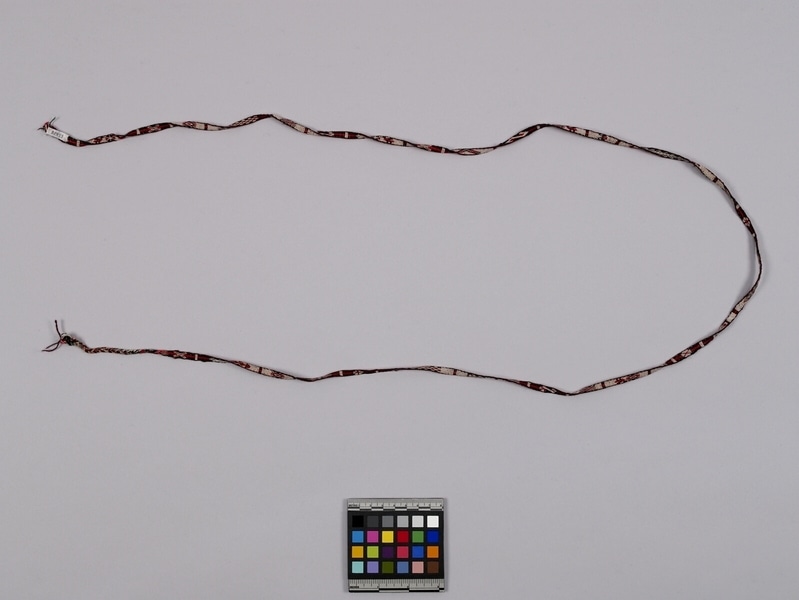Band Item Number: Sf913 from the MOA: University of British Columbia

Description
A long narrow band with a succession of tiny motifs composed of circles, spiked diamonds, crosses and reverse curves. Butterflies, birds and plants also appear. The white patterns on a green and red background are inverted on the other fabric face. The band is bordered with a dark purple strip. One end of the band is finished with a braid.
History Of Use
Warp-faced fabrics with three or four selvedges are woven by women but the fabrics the techniques, structures and some of the motifs have pre-Conquest antecedents. This type of textile conveys the most information about an individual's ethnicity, sex, age, status and particular history. Narrow bands have a number of standard uses as are used by both sexes. Straps on coca bags, ties on wide belts and wrist adornments for dancers. They have a number of ad hoc uses as well in tying anything that needs tying. In recent times, they are sewn to shirts and vests for tourists. Young girls learn weaving skills and a pattern repertory by making many tesno. Older women continue to make them.
Specific Techniques
Figurative designs; complementary-warp weave with 3-span floats aligned in alternate pairs with an irregular (abbabaab) warping order (3/1 horizontal colour changes and diagonals of 2-span floats). Warp is body tensioned between pin on skirt and big toe or ground stake.
Iconographic Meaning
The range of motifs refers to local geography and landmarks, ecology, fecundity as well as luck. The six part circle refers to the division of land into six sections on Taquile and the rotation of crops and fallow periods.
Narrative
Woven for use by the family or for sale.
Cultural Context
everyday
Item History
- Made by Candelaria Cruz Machaca (Maker) in Taquile, Puno, Peru during 1982
- Collected by Mary Frame during 1982
- Owned by Mary Frame before February 10, 1983
- Received from Mary Frame (Seller) and Museum of Anthropology Shop Volunteers (Funding source) on February 10, 1983
What
- Name
- Band
- Identification Number
- Sf913
- Type of Item
- band
- Material
- wool fibre, synthetic fibre and dye
- Manufacturing Technique
- spun, plied, braided, woven and re-plied
- Overall
- height 137.6 cm, width 0.6 cm
Who
- Culture
- Quechua
- Creator
- Candelaria Cruz Machaca (Maker)
- Field Collector
- Mary Frame
- Previous Owner
- Mary Frame
- Received from
- Mary Frame (Seller) and Museum of Anthropology Shop Volunteers (Funding source)
Where
- Holding Institution
- MOA: University of British Columbia
- Made in
- Taquile, Puno, Peru
When
- Creation Date
- during 1982
- Collection Date
- during 1982
- Ownership Date
- before February 10, 1983
- Acquisition Date
- on February 10, 1983
Other
- Item Classes
- textiles
- Condition
- good
- Accession Number
- 0861/0028